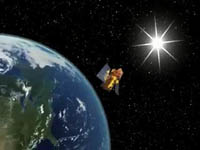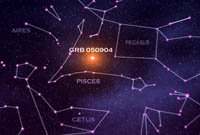Imagine the Universe News - 30 September 2005
Most Distant Explosion Detected, Smashes Previous Record
| 30 September 2005 |

|
|
Nearly 13 billion years ago, an early massive star explodes. The light from the explosion traverses the Universe. On September 4, 2005, the NASA Swift satellite detects the burst and notifies scientists of its location. (Credit: Trent Schindler/NSF) [Click image for QT movie (840 KB)] (Description) |
Scientists using NASA's Swift satellite and several ground-based telescopes have detected the most distant explosion yet, a gamma-ray burst from the edge of the visible universe.
This powerful burst was detected September 4. It marks the death of a massive star and the birth of a black hole. It comes from an era soon after stars and galaxies first formed, about 500 million to 1 billion years after the Big Bang.
"We designed Swift to look for faint bursts coming from the edge of the Universe," said Swift principal investigator Dr. Neil Gehrels of NASA Goddard Space Flight Center in Greenbelt, Md. "Now we've got one and it's fascinating. For the first time we can learn about individual stars from near the beginning of time. There are surely many more out there," he added.
Only one quasar has been discovered at a greater distance. Quasars are super-massive black holes containing the mass of billions of stars. This burst comes from a lone star. Scientists say it is puzzling how a single star could have generated so much energy as to be seen across the entire Universe. The science team has not yet determined the nature of the exploded star. A detailed analysis is forthcoming.
Scientists measure cosmic distances via redshift, the extent to which light is "shifted" toward the red, or lower energy, part of the electromagnetic spectrum during the light's long journey across the Universe. The greater the distance, the higher the redshift.

|
|
The most distant explosion ever detected occurred deep deep deep in the constellation Pisces. (Credit: NASA) [Click image for larger version.] |
The September 4 burst, named GRB 050904, has a redshift of 6.29, which translates to a distance of about 13 billion light-years from Earth. The Universe is thought to be 13.7 billion years old. The previous most distant gamma-ray burst had a redshift of 4.5. The most distant quasar known is at a redshift of 6.4.
This burst was also very long, lasting more than 200 seconds, whereas most bursts last only about 10 seconds. The detection of this burst confirms that massive stars mingled with the oldest quasars. The detection also confirms that even more distant star explosions can be studied through combined observations of Swift and the network of world-class telescopes.
"This is uncharted territory," said Dr. Daniel Reichart, University of North Carolina (UNC), Chapel Hill, who spearheaded the distance measurement. "This burst smashes the old distance record by 500 million light-years. We are finally starting to see the remnants of some of the oldest objects in the Universe," he added.
Swift detected the burst and relayed its coordinates within minutes to scientists around the world. Reichart's team discovered the afterglow using the Southern Observatory for Astrophysical Research (SOAR) telescope atop Cerro Pachon, Chile. Over the next several nights, the UNC team used SOAR and the Gemini South telescope, also on Cerro Pachon, to calculate a redshift of greater than 6 using a light filtering technique. A team led by Nobuyuki Kawai of the Tokyo Institute of Technology used the Subaru Observatory on Mauna Kea, Hawaii, to confirm the distance and fine-tune the redshift measurement to 6.29, using a technique called spectroscopy.
"The earliest stars exploded eons ago, we know very little about them," said Josh Haislip, a UNC team member who analyzed data from SOAR. "One of the best ways we can study them is by watching for their explosions. Swift can pinpoint the location of the explosions, and telescopes such as SOAR can study the composition of the debris to understand where and when these stars formed and what they were made of," he added.

